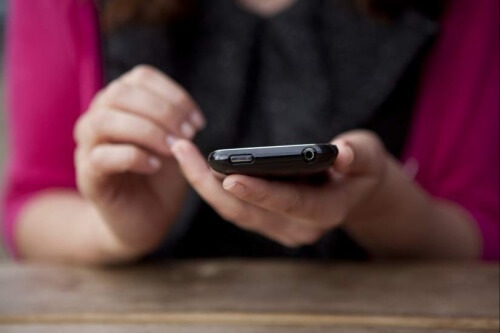Have You Heard of Smartphone Syndrome?

Have you heard of smartphone syndrome?
The arrival of new technology has had a huge impact worldwide and has revolutionized our way of life. These new devices have become increasingly present in our daily lives. They’ve have become an essential element for communication, work and many other aspects of our existence.
The smartphone is one of the most used electronic devices out there today, with an estimated 2.5 billion people owning at least one.
These devices give us access to thousands of applications for every purpose. However, experts have been warning us for some time now about their negative health effects, especially on those who develop an addiction.
One consequence of excessive mobile use is known as “smartphone” syndrome. It involves a number of physical and psychological disorders that lower the quality of life of those affected.
Many are not even aware they are suffering from the condition and that their health problems could be linked to the mobile device usage.
What types of problems are associated with smartphone syndrome?
Let’s take a look below.
The Dangers of Smartphone Syndrome
Vision problems

One of the first parts of the body to be affected are the eyes. This happens because the light these devices emit deteriorates your vision.
What makes it worse is that unlike other types of devices, smartphones are often closer to the eyes, making the impact of their light even stronger.
If a person were to spend 72 hours non-stop in front of the screen of their phone, it would destroy 93% of the photosensitive cells in the retina.
Where most experts agree is that the damage is usually irreversible, making the problem even more serious.
Fortunately, there are now filters that you can buy for the screen of your mobile device to block the harmful light rays.
Also read: Cell Phone Radiation: 10 Highest Devices
Muscle aches
Using a smartphone for several hours without giving yourself a break can cause muscle pain in areas like your back and neck.
Not knowing how manage your use and having your phone in your hands until the moment you fall asleep is almost certain to cause pain and tension in these parts of the body.
Physiotherapists who have studied this behavior reveal that the posture most people adopt while using these devices is harmful. They recommend sitting in a chair using both hands to operate the device on the table.
Using only the thumb or one finger to operate these devices also increases your risk of developing tendinitis.
Psychological disorders

When an individual feels that they’re no able to go without checking their smartphone for several hours, they’re likely to suffer severe episodes of common psychological disorders.
The dependency that these devices create increase feelings of depression, anxiety, stress and other negative emotional states. Unfortunately, these affect the person’s private, social and work life.
Believe it or not, one of the biggest influencing factors is the ability to see what others are up to. In the case of couples and close friends, this can cause worry, anxiety, or jealousy, among other things.
On the other hand, we need to keep in mind that these devices are causing many to become socially isolated. Unfortunately, they exchange real relationships with virtual ones.
Visit this article: Four Common Types of Depression
Addiction

Continuing from above, it’s important to make special mention of the addiction these devices can cause. In fact, many have had to resort to psychological therapy to overcome their smartphone dependency.
The anxiety that occurs has been compared to that of drug addicts. In fact, some have expressed feeling an emotional void from not having it in their hands after a time.
The situation is so serious that some countries have opened rehabilitation centers for those who can’t live without their smartphones.
Are you keeping your mobile device usage in moderation? Now that you know the negative effects of using it in excess, you’d better take all the relevant steps to reduce the amount of time you spend on your phone every day.
All cited sources were thoroughly reviewed by our team to ensure their quality, reliability, currency, and validity. The bibliography of this article was considered reliable and of academic or scientific accuracy.
- Comunidad de Madrid (2020). Servicio de atención en adicciones tecnológicas. Available at: https://www.comunidad.madrid/servicios/asuntos-sociales/servicio-atencion-adicciones-tecnologicas. Accessed 13/04/2020.
- García Merino, P. (2018). Los smartphones: la droga invisible del siglo XXI. Available at: https://ddd.uab.cat/record/196460. Accessed 13/04/2020.
- Gil, F., Valle, G. D., & Oberst, U. (2015). Nuevas tecnologías – ¿Nuevas patologías? El smartphone y el fear of missing out. Aloma, 2015, Vol. 33, Núm. 2. Available at: https://www.recercat.cat/bitstream/handle/2072/257438/301485-422850-1-SM.pdf?sequence=1. Accessed 13/04/2020.
- Jung, S. I., Lee, N. K., Kang, K. W., Kim, K., & Do, Y. L. (2016). The effect of smartphone usage time on posture and respiratory function. Journal of physical therapy science, 28(1), 186-189. Available at: https://doi.org/10.1589/jpts.28.186. Accessed 13/04/2020.
- Ratnayake, K., Payton, J. L., Lakmal, O. H., & Karunarathne, A. (2018). Blue light excited retinal intercepts cellular signaling. Scientific reports, 8(1), 1-16. Available at: https://www.nature.com/articles/s41598-018-28254-8/. Accessed 13/04/2020.
This text is provided for informational purposes only and does not replace consultation with a professional. If in doubt, consult your specialist.








